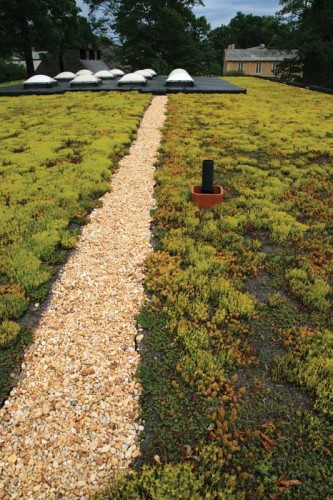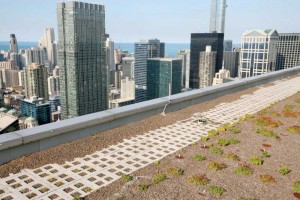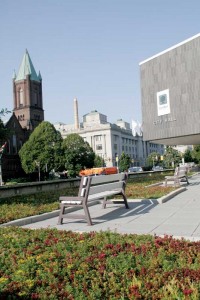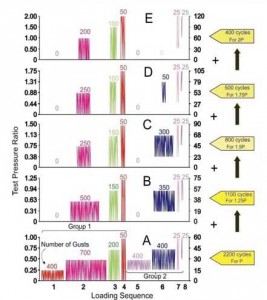Designing vegetated roofing for wind forces
by Elaina Adams | September 1, 2012 1:54 pm
 [1]
[1]By Jeff Truman, M.A.Sc., P.Eng., PMP
From a purely economic perspective, the positive impact of a vegetative ‘green’ roofing assembly is measured in the long term—40 years or more. This means ensuring its performance and safety over an extended period is crucial.
A green roof protects the underlying waterproofing membrane from the elements. Combined with a higher-quality membrane necessary to resist soil and plant forces, the result should be a longer roof lifecycle decades beyond a conventional system’s 20 to 25 years. This suits institutional real estate owners, such as schools and governments. In this author’s experience, vegetated roofs cost about twice that of a traditional assembly; this is why membrane replacement for these roofs should have double the lifespan of a traditional roof to achieve the economic benefits.
The environmental benefits of green roofs are less quantifiable. They include reducing the urban heat island (UHI) effect, adding insulation to minimize energy consumption, and improving the urban esthetic, especially for those with access to these spaces.
To achieve these intangible benefits, legislation is often required. The City of Toronto became the first major municipality in North America to mandate many new developments (i.e. those larger than 2000 m2 [21,528 sf]) to include up to 60 per cent of the roof area as vegetated. The rules allow industrial buildings to instead have a cool roof (i.e. reflective or white-membrane), as they are often in areas away from residential and office areas, and the esthetic benefits are lower.
There are no real indications green roof legislation may come to other large-scale municipalities in Canada—Toronto’s condo market may be the only one large enough to support such an initiative—but the basic lessons and best practices could certainly be applicable in many of the provinces.
Code requirements and standards
Introduced in May 2009, Toronto’s green roof bylaw (Toronto Municipal Code Chapter 492, “Green Roof”) has created a market driver for vegetated assemblies in Ontario. However, Act IV of the bylaw—Toronto Green Roof Construction Standard—provides little guidance with respect to the structural implications. It requires a wind uplift study be completed by a professional engineer and, as with all developments, landscape/architectural/structural drawings and specifications for all building areas and systems, including the green roof.
For structural design, the standard refers primarily to the Factory Mutual (FM Global) Data Sheet 1-35, Green Roof Systems, which was prepared from a loss prevention perspective. Those aspects are discussed further below, and they arise naturally from the current state of knowledge.
The Ontario Building Code (OBC) does not specifically refer to green roofs. However, it speaks to wind design for building systems and cladding components. Claddings are attached to the main structure, and experiences higher local wind forces due to their location and air turbulence. When it comes to wind design, OBC refers to National Building Code of Canada (NBC) Design Supplement, Commentary J. This resource provides equations to support OBC notations, and graphic representations of buildings with wind force co-efficients that have been developed via wind-tunnel tests, and statistically verified by reviewing building failures.
Proceeding with a wind design on the basis of OBC is therefore quite straightforward. What results, however, is a requirement the green roof’s growing medium be of a depth and density that increases the assembly’s costs and structural needs. Anecdotal evidence and testing on wall assemblies have shown vegetated roofs may not experience the full uplift forces due to ‘pressure equalization’—wind is drawn through, rather than adhered to, the material, reducing suction forces.
 [2]
[2]Photo courtesy LiveRoof
Other standards, such as American National Standards Institute/Single-ply Roofing Industry (ANSI/SPRI) Recommend Practice (RP) 14-2010, Wind Design Standard for Vegetative Roofing Systems, pertain mostly to the vegetated system itself. This standard is intended to develop consistency in the product and allows one to be compared to another. For example, the test for growing medium density is based on a ‘kiln-dry’ mass, which would not occur onsite. Therefore, it is inappropriate to use this mass for design purposes, as the growing medium would never reach ‘kiln dry’ (unless installed in a desert area). The mass is more useful to compare the growing medium quality from one product to the next.
ANSI/SPRI RP 14-2010 refers generally to American Society of Civil Engineers (ASCE) 7, Minimum Design Loads for Buildings and Other Structures, which is the wind design standard for the International Building Code (IBC) used in the United States. Canadian codes already perform wind design in accordance with this standard, but use design pressures instead of wind speeds. Regardless, OBC/NBC uplift forces govern, but there is no real guidance to any reductions due to surface irregularities or substrate permeability. Essentially, the ANSI standard does little to enhance the state of knowledge, but simply collects information directly pertaining to vegetated roofs.
As mentioned, FM Global has developed a green roof design and installation guide that generally describes ways to limit the possibility of an insurance loss. The document is written from FM’s perspective, showing the firm has seen green roof failures, and understands the causes. Therefore, it could be argued the specific issues raised by FM are the overriding concerns facing the design of vegetated roofs today.
In addition to the bylaw, the City of Toronto provides design guidance with its supplemental design guide, which mainly speaks to the horticultural issues; the section relating to wind design is based primarily on the FM guide. The City guide refers to the development of another standard, one by Green Roofs for Healthy Cities (GRHC), but this is the aforementioned ANSI one.
Design issues
Following the OBC/NBC method, there is a perimeter zone (size depending on the building dimensions) around the edge that experiences much higher wind loads—about 50 per cent higher than at the rest of the roof area. The corners experience even greater wind forces. This is due to turbulence at the roof edge, and a sudden expansion of the air compressed up the wall. In many designs, the increased wind load results in no plantings at the edge zone, due to weight concerns and the ability of the growing medium to resist scour (i.e. the removal of dirt or stones by wind). The FM guide recommends keeping this edge zone free of plantings to limit losses due to high winds.
The soil can be as deep as necessary to resist the wind uplift forces—this depends on both the expected winds (the lower the building, the lower the wind speeds and uplift) and the composition of growing medium. However, if it is not a contiguous mass, there is concern for scour to remove the soil. If this process occurs rapidly, the entire ballast could be removed. It is therefore essential the plantings are fully rooted, or some means have been provided to ensure the soil mass is contiguous or secured.
Piles of dirt on the ground do not suddenly blow away—there is some cohesion of the soil to hold itself together. Tornadoes do not regularly lift dirt off the ground, for example, at least not beyond the loose layers. However, sand dunes move. In other words, the amount of movement depends on the soil composition. When it comes to vegetated roofing, this author feels there is not enough guidance in this respect.
 [3]
[3]Photo courtesy LiveRoof
There is significant research literature from wind-testing on roofing materials from the 1970s and 1980s, undertaken at the National Research Council (NRC) in Ottawa. The studies suggest there is a pressure-equalizing effect that reduces uplift forces with objects such as pavers, though not once objects reached ‘fist’ size. There is no understanding of the pressure-equalizing effect with respect to vegetation. There is also research regarding the performance of roof membranes that might be applied to vegetated roofing assemblies that are thin and fully connected (by roots or other means). The vegetated system could then act like a loose carpet on top of the building. However, since it is much more permeable than a membrane, it may not act as a mat—wind may move through the medium, reducing the total overall uplift. (This is akin to comparing a solid umbrella to one with ‘layers’ that let the wind through.) More research is required.
Some green roof systems employ mature plantings in trays with sufficient mass of soil to resist the uplift forces. The concern becomes what would happen if a tray flips when wind can get under its edge. The suction (i.e. uplift) forces for which roofs are designed are much less than the direct pressure of the wind. When the suction is enough to lift an edge, that direct force is easily capable of continuing to push; if one tray lifts and flips, this could create a zipper effect, peeling open the vegetated trays.
One solution is to connect the trays together to create a raft, reducing the possibility of local failures. In high-wind areas, one should specify adhesive roof anchors that connect directly to the membrane, which is fully adhered to the roof deck. The anchors are located on spacings that suit the uplift forces and their connection strength.
This raft effect has an impact on those vegetated systems that are literally rolled out onto the roof. One manufacturer does this for the reinforced growing medium, and the plantings are placed into it; the company says root establishment takes place within six months. In this case, once the mat becomes one contiguous mass, its entire weight must be compared with the sum of the uplift force over its area. Uplift occurs at high-wind locations, especially roof edges and corners. This may create some flapping, but is unlikely to cause an overall failure, unless the sum of the wind forces exceeds the mat’s weight.
Wind force is not consistent over the entire roof area. This effect is also applicable for roof insulation ballast design, where scrim sheets are often called ‘ballast-reducers.’ The scrim sheet distributes higher local wind forces onto an insulation board over a wider area. Connecting individual elements into a larger raft produces a similar effect as a scrim sheet.
The calculated uplift forces are local maximums. This means, at any given spot, the ballast must resist this uplift force to limit the possibility of any individual element failing. In the case of vegetated trays, a local failure could result in the tray flipping, the soil being displaced, and then the tray, plants, and growing medium blowing off the roof. Once a small degree of uplift occurs, wind can grab the free edge and the direct forces from wind are much higher than the associated uplift. It is therefore critical to limit local uplift failures.
Due to surface roughness, there may be ameliorating effects on the uplift force because of shedding of the suction at the growing medium’s surface. Some studies have indicated these effects may be occurring, but have not quantified them enough to be considered in design. The building industry understands loose ballast is not lifted off the roof, and can resist scour if properly graded; the industry also understands the appropriate mass and location of pavers for the most part. Vegetated roofs intuitively would withstand uplift forces somewhere in the middle of these two cases, but further wind-tunnel testing is required to determine this.
Industry issues
Currently, few manufacturers have not met the challenge of offering competent wind design data. A German company has provided design guidance suggesting only four per cent of the design wind uplift is actually ‘felt’ by the green roof system. Its study is based on the rainscreen principle of cladding design, where mitigation of the uplift force is provided by pressure equalization within permeable materials. However, testing to acceptable standards is required.
Other manufacturers have relied on increasing the depth of the planting medium. This can be accommodated in new design, where the extra dead load can be accommodated with minor increases in steel or concrete depths (for reinforced concrete roofs), or with slightly larger beams or reduced spacings (for steel roofs).
In higher-wind locations, or where local forces require deeper ballast is required, mechanical anchorage of the green roof system may be more economical, or even a necessity. Project economics could also direct this decision, as there will be a trade-off between the costs of increased ballast versus the labour to install mechanical anchors.
Existing roofs
For existing roofs, the structure is typically designed for the originally anticipated loads (live and dead), but nothing more. Therefore, without some other structural modifications, the roof cannot accommodate the additional load of mature vegetation, along with associated materials and water. Strengthening the roof structure is most often cost-prohibitive, unless it is for another purpose—such as to create usable space.
 [4]
[4]Image courtesy Bas A. Baskaran, PhD, P.Eng., National Research Council of Canada (NRC)
A vegetated roofing assembly could replace the existing roof ballast, and a lighter-weight roof may be used to accommodate the vegetation. It might also be appropriate to review additional capacity required by code changes, tested concrete in-situ strength, or load and materials factors. Some situations may permit changes to the roof assembly that amount to a small percentage of the overall loads. Any increased dead loads must consider effects to long-term deflections, particularly for wood structures.
Testing
In 1994, NRC created the Special Interest Group for Dynamic Evaluation of Roofing Systems (SIGDERS), which then developed a method and test apparatus of testing materials against uplift forces. NRC’s work resulted in Canadian Standards Association (CSA) A123.21-04, Standard Test Method for the Dynamic Wind Uplift Resistance of Mechanically Attached Membrane Roofing System, which should be the governing test standard for vegetated roofs in Canada. With this testing in hand, manufacturers are able to demonstrate their systems provide the required resistance to wind uplift, ensuring the safety and durability of the vegetated roof system.
SIGDERS allows testing under gust conditions, applying suction forces in a cyclic pattern reminiscent of fatigue testing for metals. (For more information, see “Top 10 Questions and Answers on Static vs. Dynamic Wind-testing for Commercial Roofs,” by Bas A. Baskaran, PhD, P.Eng., in the September 2006 issue of Interface, the RCI International magazine).
This better mimics actual site conditions, and allows an understanding of how cladding materials perform under in-situ conditions. The process can therefore be used by manufacturers to obtain an uplift rating on their systems. When combined with the other design considerations noted in this article (e.g. edging and rafting), a safe and durable green roof can be provided.
Conclusion
With any new technology or design, successful implementation relies on an understanding of the design issues and existing guidelines. For vegetative roof assemblies, one of the missing pieces can be wind uplift ratings from the system manufacturers. In other words, designers and building owners who want to ensure their green roof stays on the roof should have it tested.
Jeff Truman, M.A.Sc., P.Eng., PMP, is a professional engineer in Toronto. He operates Truman Engineering Services Inc., a boutique cladding/structural design and building rehabilitation consultancy. Truman has provided wind studies on more than a dozen new roofs in the past two years. He can be contacted via e-mail at jeff@truman.ca.
- [Image]: https://www.constructioncanada.net/wp-content/uploads/2015/11/dreamstime_xl_14714889.jpg
- [Image]: https://www.constructioncanada.net/wp-content/uploads/2015/11/Soil-is-blowing-around-and-over-edge-of-building.jpg
- [Image]: https://www.constructioncanada.net/wp-content/uploads/2015/11/London-City-Hall.jpg
- [Image]: https://www.constructioncanada.net/wp-content/uploads/2015/11/SIGDERS-Cycling-from-powerpoint.jpg
Source URL: https://www.constructioncanada.net/designing-vegetated-roofing-for-wind-forces/